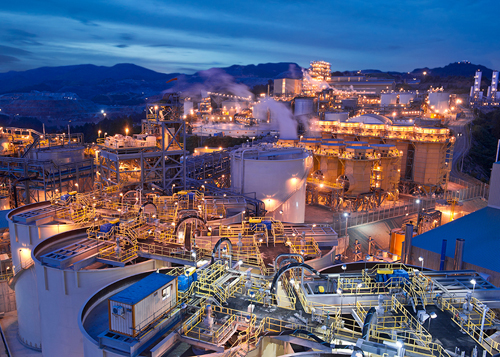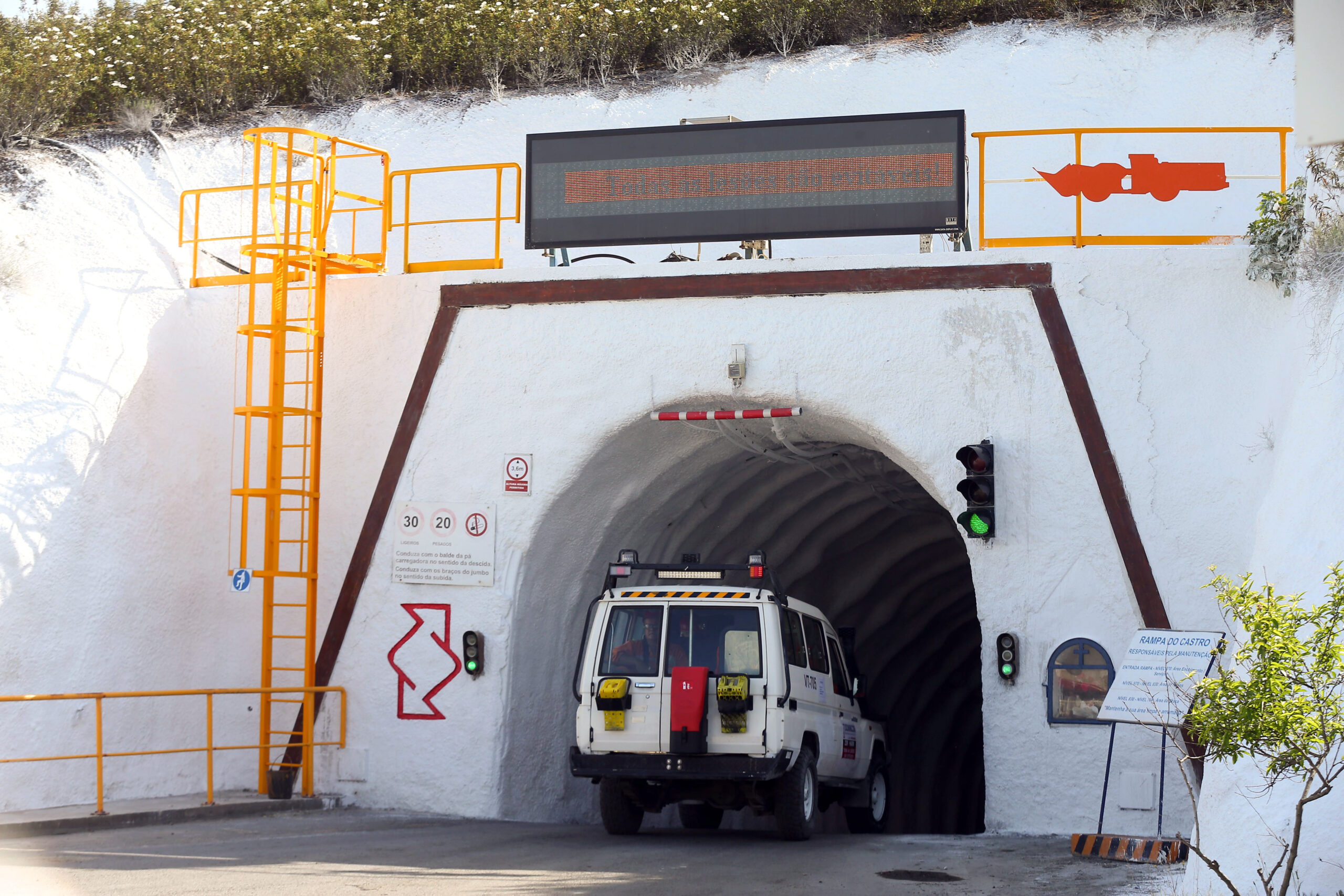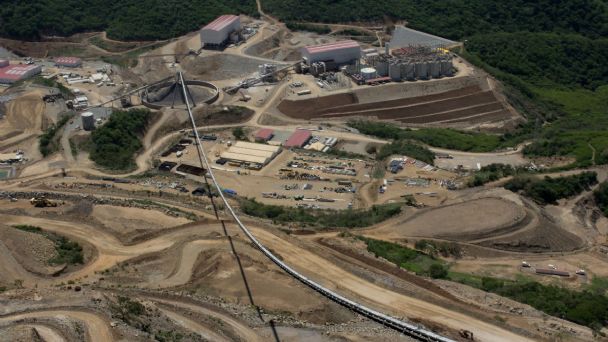
For many years tourism and agriculture have been the traditional drivers of economic growth for the Dominican Republic. However in more recent times a third pillar has been slowly emerging and developing and that is mining. Today the sector is a cornerstone of the country’s economic prosperity, with the mining industry’s contribution to its GDP rising by as much as 74 percent in 2011 alone.
Located approximately 100 kilometres northwest of the capital city of Santo Domingo, the Pueblo Viejo mine represents one of its most significant investments to date and the largest foreign investment in Dominican Republic history, with mine construction capital of approximately $3.8 billion. With declared reserves of 23.7 million ounces of gold, Pueblo Viejo holds by far the richest deposits of gold ever identified in the country. The site, which is a sulphidic refractory gold deposit, is currently being developed to a 24,000 tonne-per-day design capacity.
The mine comprises two major oxide deposits known as Monte Negro and Moore, and three other small deposits. Moore is the largest deposit and is separated from Monte Negro by 500 metres of barren mud-stones.
The mine had been in production since 1975. It was operated by the state-owned mining company Rosario Dominicana. The mine had produced more than five million ounces (moz) of gold and 22moz of silver in its operational life. The mining operations had to be halted, however, in 1991 due to low gold and silver prices and a lack of appropriate technology to process the ore.
The Dominican Government first invited tenders for the project in 2001. One key aspect of the work required remediation of the site which had been badly damaged by earlier abandoned mining operations. The other centred on the development of new operations to extract and process the gold containing sulphurs of the mine.
The tender was initially won by Placer Dome Inc., which was subsequently acquired by Barrick. By 2009 the complex negotiations to develop Pueblo Viejo were complete and a 60/40 consortium with Goldcorp – the Pueblo Viejo Dominicana Corporation (PVDC) – in which Barrick holds the controlling interest, was busy constructing this multi-billion dollar facility.
Barrick Gold carried out the feasibility study and appointed Ruscan Environmental Sciences of Canada to perform the environmental and social impact assessment, and associated infrastructure studies. Understandably for a project of this size a number of challenges had to be overcome in bringing the mine to where it is today, not least of all the challenge that centred on leading one of the mining industry’s most ambitious environmental rehabilitation projects. Before the building phase could commence, the land had to be cleared and restored. A massive clean-up effort was required as a result of the improper closure of a former mine on the property in 1999.
Initial findings showed heavy metal concentrations, acidity and sediment in local waterways. The primary sources of soil and water contamination were the historic open mine pits, waste rock piles, the abandoned plant facilities and tailings storage areas. The Margajita River that passes through the hills near the site had been dubbed the “Coca-Cola river” by locals because of its dark colour—the result of having absorbed so much acid rock drainage from the former mine.
The final team consisted of Barrick Gold employees, hazardous materials experts and new employees hired locally and specially trained for the operation. One of the first tasks was to take over a thousand samples to define soil in the area into different categories and determine future treatment and landfill options. Buildings on the property also contained different types of hazardous waste that had to be categorized and disposed of in a safe manner.
Approximately 130,000 cubic metres of soil were removed to rid the ground of contaminants. Bioremediation, a process that relies on microorganisms to return altered land to the natural environment, was successfully used to treat almost 100,000 cubic metres of hydrocarbon contaminated soil.
In addition to the clean-up of hazardous substances within the mining areas, it was proposed that the clean-up of the surrounding areas would cost the Dominican Government an additional $75 million and the company would contribute $37.5 million with the other half coming from state funds. In the end, Barrick offered to take on the full estimated cost of remediation of the surrounding areas to help improve local living conditions. To complement the clean-up, Barrick has also sponsored a significant reforestation project in the area.
Barrick also has a proud record of helping to improve the health status of the area through its use of a community-based approach to partnership with local agencies. Cholera and dengue fever are endemic in the locality and since 2009 Barrick has funded a health prevention educational programme that reached tens of thousands of people. Two hundred Dominicans, mainly young people, were trained to work with the local municipalities of Cotuí, Fantino and Maimón. The teams visited households with the goal of educating residents on hygiene, family, and environmental health.
The importance of this programme has been recognised as a significant factor in reducing the presence of dengue fever in the province, according to the local Health Department. Since the completion of the second phase of the programme, which was sponsored by the Ministries of Labour and Public Health, Barrick and the local municipalities of Cotuí, Fantino and Maimón, there have been no reports of cholera or dengue fever cases in the region.
In August 2012, Barrick Gold Corporation announced that the Pueblo Viejo mine had achieved first gold production, with ore being processed through the first two of four autoclaves. “Bringing this mine successfully into production on schedule, within capital guidance and with an excellent safety record is the result of tremendous efforts from across the company,” said Jamie Sokalsky, President and Chief Executive Officer of Barrick at the time. “Pueblo Viejo is a world-class asset, one of only a handful of mines that will produce more than one million ounces of gold per year. We expect it to be a major contributor of low cost production to Barrick for decades to come.”
Five months later, in January 2013, the company announced it had achieved commercial production at the mine. Pueblo Viejo was completed at a capital cost of $3.7 billion and created more than 11,000 direct jobs during the construction phase of the project. The operation is expected to support about 2,000 direct jobs plus nearly 10,000 indirect jobs over its 25-plus year mine life, with Dominicans accounting for nearly 90 percent of the full-time workforce.
With commercial production achieved, Barrick is now in the midst of plans to ramp up to full capacity in the first half of 2014. Barrick’s share of full-year 2013 production from Pueblo Viejo is anticipated to be about 500,000 ounces of gold at all-in sustaining costs of $700-$750 per ounce.
Barrick’s share of average annual gold production in the first full five years of operation is anticipated to be 625,000-675,000 ounces at all-in sustaining cash costs of $500-$600 per ounce and total cash costs of $300-$350 per ounce. Including depreciation of mine construction capital, costs are expected to be $650-$750 per ounce.
In other news, a 215 MW dual fuel power plant at an estimated cost of approximately $180 million was successfully commissioned towards the end of 2013 by its Finnish manufacturer Wärtsilä. The plant has the ability to transition from heavy fuel oil (HFO) to lower cost liquid natural gas (LNG).
It goes without saying that a number of contractors and businesses have helped contribute to the success of the Pueblo Viejo mine since Barrick became involved with the project. One such business that has been playing a crucial role is SERVINCA, which was contracted to construct 30 kilometres of four-to-thirty six foot long HDPE and carbon steel underground piping utilities for the potable, freshwater, firewater and storm sewer systems of the mine’s process plant site, as well as the power distribution and communications networks from the Main Substation to all of the process plant site facilities and surrounding areas.
Boasting over 33 years of experience in the execution of multidisciplinary projects covering the electrical, mechanical and civil areas for the private and public sectors, the main focus of SERVINCA in the Engineering and Construction of Electromechanical and Civil projects is to provide the highest quality and safety standards to each of its clients.
SERVINCA’s vast experience allows it to provide multiple engineering solutions to its clients for energy generation, transmission, distribution and electrical or mechanical industrial projects such as beer plants, airports, hydro electrical dams, metro, substations, structural steel fabrication and similar works for the mining sector.
As a general contractor, SERVINCA has executed several projects at the mine that fall under the disciplines of piping, metal-mechanical, steel structures, earthworks, concrete works and others such as sheet piling, geomembrane, geotextile, gabions and concrete structures.
SERVINCA is understandably proud to be part of the construction of the 34.5kV overhead transmission lines for the mines process plant site and surrounding areas. To date it has successfully executed electrical, instrumentation, fibre optic networks, substations, pole-mounted transformers, civil works, and medium and low voltage installations along the process plant site. As demanded by its client the electrical systems that have been built have been done so to the highest quality standards, providing an efficient service that corresponds with the top international mining levels.
One particularly impressive statistic, released in December 2012, showed that SERVINCA has achieved a total of 1.2 million man hours without experiencing a single lost time incident in the course of carrying out any of its projects at the Pueblo Viejo mine. The construction of the process plant site was completed, commissioned and commenced full production in 2012, and SERVINCA is proud to have been selected by Barrick as one of the main general contractors supporting the operation process by providing engineering , construction and maintenance services for the process plant site facilities.
It should be highlighted that Barrick does indeed recognise that the mine has a finite life, despite the fact the production phase should last for at least 25 years. There is therefore a strong emphasis on planning for a sustainable and diverse future. Barrick has just provided seed capital for a business incubation bureau in Cotuí to assist the start-up of new businesses in the area that are non-mining related.
When the mine finally closes, significant reserves will have already been placed in trust with the Dominican government to deal with the eventuality. Meanwhile, Barrick does retain the belief that the mine´s lifespan is likely to be significantly longer than current projections suggest.
It believes strongly that there is additional gold at Pueblo Viejo, but the declaration process is very complex and it is extremely common in this industry for mines to have undeclared reserves. Also, the steady rise in the price of gold allows it to mine ever smaller concentrations of gold and if this trend continues it is likely to extend the life of the mine still further.
One thing that the company is absolutely certain of is that it will be leaving this site in a much better condition than it found it. When the mining operation closes it will be done in a proper manner to international standards. At Pueblo Viejo Barrick intends to bring to bear all the know-how and experience gleaned from mining operations across the globe and leave behind a vibrant and dynamic local community and economy.
Whatever the long term future holds, it cannot be disputed that Pueblo Viejo has the potential to revitalise a region where nearly half the population lives below the national poverty line. This potential is already starting to be realised as the mine continues to bring much-needed diversification to the Dominican economy.
Written by Will Daynes, research by Vince Kielty



 BarrickPV-Americas-Mining-Mar14-Bro-s.pdf
BarrickPV-Americas-Mining-Mar14-Bro-s.pdf









